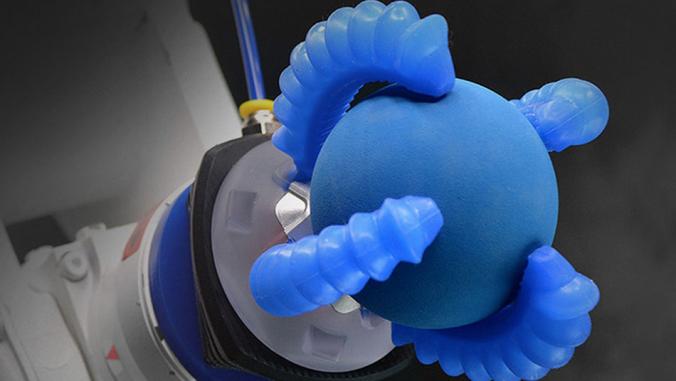Learning From Nature to Use Less Material and Energy
Solutions in nature that require the least effort and least material are fertile grounds for builders' research. Least-material solutions often mean least-energy solutions, and these savings may mean the difference between survival and oblivion for organisms. Similar solutions applied to, or avoided by, businesses can bring a variety of benefits or costs.

The subject of building has traditionally been about structure, but we live in exciting times and now it includes those other two phenomena, information and energy, and it's about time! Sometimes in nature the boundaries among the three are indistinguishable, and in my last post I gave the example of the molecular structure of proteins actually being the message that begins the work.
The ultimate message is, of course, DNA, and the ultimate goal of all living organisms is to carry this message forward into the future. All of nature's building strategies must be judged with this in mind. This message is best viewed, not as a blueprint, but as a recipe. The DNA in the organism merely sets in motion an intricate pattern of protein formation and the proteins get to work building the beast, cell by cell.
From this goal of DNA survival, therefore, flow two opposite, but complementary, strategies: durability on the one hand and expendability on the other.
Seed pods can lie dormant for decades before getting that activating raindrop. Fertilized lowers will be precisely programmed to kill their base cells in order to drop the now useless stamens. All is possible because information is imparted in a timely way, all matter can ultimately be recycled, and the energy flow never stops. Principles that all engineers might live by, once they accept the fact that nothing ever remains the same.
Since the passing on of its DNA is the paramount goal of every organism's life, there's a lot of competition out there, and not everyone's a winner. The successful strategies and forms will persist through this natural selection. This process almost guarantees that least-effort solutions will emerge. This is why another of nature's rules seems to be that organisms like to surf for free. Soaring birds, drifting larvae, and hitchhiking seedpods are all simple examples, but the natural world is full of complex and bizarre interactions that involve getting a free lunch.
Solutions in nature that require the least effort and least material are fertile grounds for builders' research. A tree is a good example. Lifting a water column up over 400 feet defies the bounds of atmospheric pressure, but it is done by the vacuuming power of osmosis in the tree's leaves and the surface tension of water clinging to itself and the walls of xylem. Daily water transport in a coast redwood tree is nothing short of prodigious; all done without engines or engineers.
Least-material solutions often mean least-energy solutions, and these savings may mean the difference between survival and oblivion for organisms. It is the shape that is important in many of these structural solutions.
The much-studied abalone shell (photo above) is a case in point. Its composite construction of calcium carbonate and protein layers is estimated to be 3,000 times stronger than the individual materials it is made of. Calcium carbonate is the same material as blackboard chalk. It's not a promising high-strength material, but it is dirt cheap in the surrounding seawater, and the abalone has evolved to capture it easily and use it to its highest and best performance.
This shape-for-strength strategy does not stop at the molecular level, but runs through many hierarchies of scale right up to the domed shape that you can run a light truck over.
When a company, such as IBM, reduces its industrial water use, it also finds that it reduces its energy use as well. At its Burlington, Vermont, computer chip factory, the company reduced its water consumption by 27 percent, and was surprised to discover that 60 percent of their $3 million annual savings was from using less energy to pump, cool and heat that water. Using fewer resources led to using less energy.
Least-energy solutions can also be seen when you jump biological scales. For example, your atoms make up molecules, which make up cells, which make up tissues, which make up organs, and so on up through to the level of the biosphere. The phenomena of emergence and self-organization are worth studying with this in mind.
Emergence might be described most simply as the whole being a product of its parts, and an emergent product cannot be explainable though an examination of each of those parts. Your mind, for instance, is much more than the assemblage of neurons found in your brain
Self-organization is often allied with the idea of emergence and is familiar to us in the form of cloud computing and termite colonies. A simple set of behavioral instructions determines individual behavior, but because of feedback interactions within a group, a complex new larger pattern or phenomenon emerges. There is a randomness to it, but nature has been creatively employing randomness for millennia in forming DNA.
Termites, by the way, with brains the size of a pinhead and using simple, pheromone-triggered behaviors, are able to build the world's tallest structures, if measured in scale to the size of the builder. Sorry, Dubai.
For today's architects and engineers, nature's lessons on emergence seem most germane when smart buildings are allied with smart grids. Environmental monitors and controls in individual buildings, connected by internet to a utility's grid control station, will not only achieve energy savings in the individual building but will also contribute to efficiency within the larger grid. Demonstration projects are already underway at selected places like the University of New Mexico.
There, buildings are not only wired for remote control of the building environment, but also to a network of other buildings and external factors. A Global Energy Management for Sustainability (GEMS) Web Portal provides energy data and a host of other intelligence to building managers. These managers can then establish Key Performance Indicators (KPI) to assess the effectiveness of facility operations campus-wide or for individual buildings. For now, human operators select the desired key indicator, like carbon footprint, and quickly see a color-coded rating of a building. They then can delve deeper into the individual building's information systems to locate the source of a poor rating. Eventually, the goal is for these kinds of adjustments to happen automatically. In the future, according to Jack McGowan, CEM of Energy Control, Inc., “It will be possible for systems to be integrated and programmed to execute self-learning applications and optimize energy performance to achieve new levels of sustainability.”
While we have much to be proud of in our building, we have much to learn from nature, and studying nature's rules and learning the principles behind nature's forms seems the best path to the innovation that we need.
Tom McKeag teaches bio-inspired design to undergraduate design students at the California College of the Arts and to graduate architectural, science and engineering students at the University of California, Berkeley. He is the founder and president of BioDreamMachine, a nonprofit educational institute that brings bio-inspired design and science education to K12 schools. In 2006, McKeag helped establish the nation's first public elementary school course in biomimicry at the Dixie Elementary School in Marin County, Calif. In his spare time he works as a licensed landscape architect and community planner.
Abalone shell - CC license by midnightcomm
The ultimate message is, of course, DNA, and the ultimate goal of all living organisms is to carry this message forward into the future. All of nature's building strategies must be judged with this in mind. This message is best viewed, not as a blueprint, but as a recipe. The DNA in the organism merely sets in motion an intricate pattern of protein formation and the proteins get to work building the beast, cell by cell.
From this goal of DNA survival, therefore, flow two opposite, but complementary, strategies: durability on the one hand and expendability on the other.
Seed pods can lie dormant for decades before getting that activating raindrop. Fertilized lowers will be precisely programmed to kill their base cells in order to drop the now useless stamens. All is possible because information is imparted in a timely way, all matter can ultimately be recycled, and the energy flow never stops. Principles that all engineers might live by, once they accept the fact that nothing ever remains the same.
Since the passing on of its DNA is the paramount goal of every organism's life, there's a lot of competition out there, and not everyone's a winner. The successful strategies and forms will persist through this natural selection. This process almost guarantees that least-effort solutions will emerge. This is why another of nature's rules seems to be that organisms like to surf for free. Soaring birds, drifting larvae, and hitchhiking seedpods are all simple examples, but the natural world is full of complex and bizarre interactions that involve getting a free lunch.
Solutions in nature that require the least effort and least material are fertile grounds for builders' research. A tree is a good example. Lifting a water column up over 400 feet defies the bounds of atmospheric pressure, but it is done by the vacuuming power of osmosis in the tree's leaves and the surface tension of water clinging to itself and the walls of xylem. Daily water transport in a coast redwood tree is nothing short of prodigious; all done without engines or engineers.
Least-material solutions often mean least-energy solutions, and these savings may mean the difference between survival and oblivion for organisms. It is the shape that is important in many of these structural solutions.
The much-studied abalone shell (photo above) is a case in point. Its composite construction of calcium carbonate and protein layers is estimated to be 3,000 times stronger than the individual materials it is made of. Calcium carbonate is the same material as blackboard chalk. It's not a promising high-strength material, but it is dirt cheap in the surrounding seawater, and the abalone has evolved to capture it easily and use it to its highest and best performance.
This shape-for-strength strategy does not stop at the molecular level, but runs through many hierarchies of scale right up to the domed shape that you can run a light truck over.
When a company, such as IBM, reduces its industrial water use, it also finds that it reduces its energy use as well. At its Burlington, Vermont, computer chip factory, the company reduced its water consumption by 27 percent, and was surprised to discover that 60 percent of their $3 million annual savings was from using less energy to pump, cool and heat that water. Using fewer resources led to using less energy.
Least-energy solutions can also be seen when you jump biological scales. For example, your atoms make up molecules, which make up cells, which make up tissues, which make up organs, and so on up through to the level of the biosphere. The phenomena of emergence and self-organization are worth studying with this in mind.
Emergence might be described most simply as the whole being a product of its parts, and an emergent product cannot be explainable though an examination of each of those parts. Your mind, for instance, is much more than the assemblage of neurons found in your brain
Self-organization is often allied with the idea of emergence and is familiar to us in the form of cloud computing and termite colonies. A simple set of behavioral instructions determines individual behavior, but because of feedback interactions within a group, a complex new larger pattern or phenomenon emerges. There is a randomness to it, but nature has been creatively employing randomness for millennia in forming DNA.
Termites, by the way, with brains the size of a pinhead and using simple, pheromone-triggered behaviors, are able to build the world's tallest structures, if measured in scale to the size of the builder. Sorry, Dubai.
For today's architects and engineers, nature's lessons on emergence seem most germane when smart buildings are allied with smart grids. Environmental monitors and controls in individual buildings, connected by internet to a utility's grid control station, will not only achieve energy savings in the individual building but will also contribute to efficiency within the larger grid. Demonstration projects are already underway at selected places like the University of New Mexico.
There, buildings are not only wired for remote control of the building environment, but also to a network of other buildings and external factors. A Global Energy Management for Sustainability (GEMS) Web Portal provides energy data and a host of other intelligence to building managers. These managers can then establish Key Performance Indicators (KPI) to assess the effectiveness of facility operations campus-wide or for individual buildings. For now, human operators select the desired key indicator, like carbon footprint, and quickly see a color-coded rating of a building. They then can delve deeper into the individual building's information systems to locate the source of a poor rating. Eventually, the goal is for these kinds of adjustments to happen automatically. In the future, according to Jack McGowan, CEM of Energy Control, Inc., “It will be possible for systems to be integrated and programmed to execute self-learning applications and optimize energy performance to achieve new levels of sustainability.”
While we have much to be proud of in our building, we have much to learn from nature, and studying nature's rules and learning the principles behind nature's forms seems the best path to the innovation that we need.
Tom McKeag teaches bio-inspired design to undergraduate design students at the California College of the Arts and to graduate architectural, science and engineering students at the University of California, Berkeley. He is the founder and president of BioDreamMachine, a nonprofit educational institute that brings bio-inspired design and science education to K12 schools. In 2006, McKeag helped establish the nation's first public elementary school course in biomimicry at the Dixie Elementary School in Marin County, Calif. In his spare time he works as a licensed landscape architect and community planner.
Abalone shell - CC license by midnightcomm





